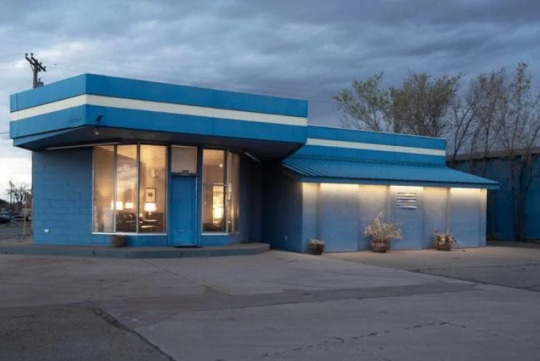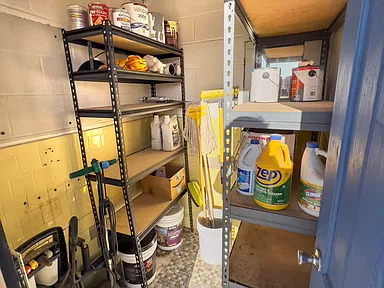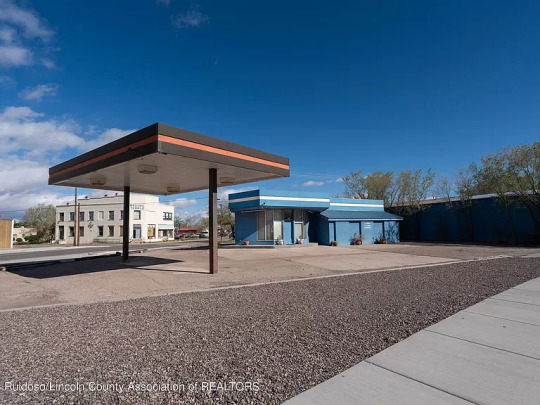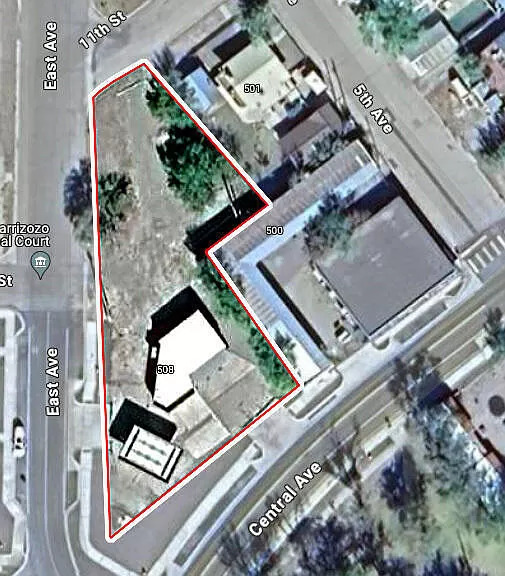#converting to gas
Explore tagged Tumblr posts
Text


This is very different from the usual homes I post from New Orleans, LA. This is a converted 1918 gas station, designed by local artist Robert Guthrie. It has 1bd, 2ba, 2,167sqft, and they're asking $775k.

The interior has remained original.

You can tell that the brick wall has been exposed to some hard work, b/c of it's dark patina.

Too bad it doesn't come furnished b/c they have some very cool things, like that red tiger.


Extremely open concept industrial loft space.


Look at all the vintage industrial furniture. I wonder if they would leave that old gas pump. I like the vintage garage doors, too.

This would've been the front office. There's another vintage pump in the corner.


These stairs lead up to the bedroom loft. Love that they have a laundry area. That's always a plus.


The kitchen features high-end gourmet appliances like the Wolf stove.

The artist used car emblems on some of the cabinets. In an industrial design, I don't mind laminate counters b/c they come in bright colors.

You can see the loft from the kitchen and the artist fashioned the loft out of the old hydraulic car lift.

Wonder if they'll leave the Pegasus sign.


A spacious main bath with black subway tiles is off the kitchen.

Up in the sleep loft. If they take the car canopy, it will ruin the whole effect.

The ensuite right off the bedroom is a nice big shower room.


Behind the divider at the back of the main floor, there's a clothes closet and storage.

The spiral stairs go up to the rooftop deck.

This is lovely. 3,000sqft corner lot.


https://www.zillow.com/homedetails/3300-Dumaine-St-New-Orleans-LA-70119/2086267839_zpid/
119 notes
·
View notes
Text

love the way he goes 'O-O!' here... kitty
#natsume yuujinchou#matoba seiji#gifs#from the alleywei#thank u animation team ;-;#get converted into a gif for looping 💥#uchi no toushu-sama ga konnani kawaii wake ga nai..!#(our head of the clan cant be this cute..!)
56 notes
·
View notes
Text




#gas#classic cars#classic car#classic#old#old car#vintage#vintage car#Hudson#vintage Hudson#convertable#convertible cars#grass#blue skys#out door#out side
29 notes
·
View notes
Text
hi everyone! celebrating @alliwantforchristmasislou by sharing my $20 donation (that is being matched by organization dollar for dollar, not sure if this is relevant but adding anyway) for Equality Florida! As a Florida native, it's been disheartening to see how the LGBT community has been unfairly vilified for political gain at the expense of our lives, so I wanted to donate to somewhere close to home.
This has made finding this wonderful online community I've found in the bucktommy fandom all the more special! I love when a tv show sucks me and makes me go a little bit insane and it's even better when I get to do it with genuinely good people. No matter what happens I'll always be grateful for that.

#alliwantforchristmasislou#bucktommy#lou ferrigno jr#still wild to me that after years of watching 911 it's tommy kinard that finally broke me but there you have it#the power lfjr hold to convert from me a ga to full on bt warrior
41 notes
·
View notes
Text

Truck Fuel Payment Kiosk (one of three terminals) at the Service Plaza in Westborough, Massachusetts on the Mass Pike (Interstate Highway 90).
#It took me 45 minutes to convert this into a gif#Sunday evening activities#reluctantly resorts to adobe express#my second gif#trucks#truck#liminal space#massachusetts#techcore#webcore#gas station#low refresh rate
7 notes
·
View notes
Text
Why do cars now not get better gas mileage?
That's a perceptive observation—while engine technology has advanced significantly, the average fuel economy of new vehicles in the U.S. has stagnated since 2014 after decades of improvement. Here’s why, distilled into key factors:
⚖️ 1. Vehicle Size & Weight Have Skyrocketed Shift to Trucks/SUVs: Over 80% of new vehicles sold in the U.S. are trucks, SUVs, or crossovers—up from 50% in 2013. These are inherently heavier (+800–1,500 lbs vs. sedans) and less aerodynamic.
Safety Regulations: Airbags, reinforced frames, crash structures, and advanced driver aids add 200–500 lbs per vehicle vs. 2000s-era cars.
Feature Bloat: Panoramic roofs, power seats, advanced infotainment, and sound-deadening materials add mass.
🚀 2. Performance Expectations Have Increased Power Over Efficiency: In 2000, the average vehicle had 172 HP and 0–60 mph in 10.5 seconds. Today: 246 HP and 0–60 in 7.5 seconds—despite added weight.
Turbocharging Trade-Offs: Smaller turbo engines (e.g., 2.0L 4-cyl replacing V6s) boost power but often underperform EPA ratings in real-world driving due to turbo lag and driving habits.
🔧 3. Emissions Controls Reduce Efficiency Gasoline Particulate Filters (GPFs): Mandatory in Europe and some U.S. models post-2020 to trap pollutants—they restrict exhaust flow, increasing backpressure and lowering MPG by 2–5%.
Lean-Burn Engine Limitations: Stricter NOx regulations prevent the use of ultra-lean combustion modes that could boost MPG.
🔌 4. Hybrids/Electric Focus Divert Innovation Automakers invest heavily in EVs and plug-in hybrids to meet regulations. Gains from these vehicles offset stagnant gas-engine MPG in fleet averages, but pure gasoline engines see fewer breakthroughs.
Example: Toyota shifted R&D from next-gen gasoline engines to solid-state batteries.
🌪️ 5. Aerodynamics Hit a Wall Despite advanced modeling, drag reduction gains are marginal:
1980s sedans: Cd ~0.35
2024 sedans: Cd ~0.27 (optimal)
SUVs/trucks: Cd ~0.30–0.40 due to height and frontal area. Further improvements are costly and limited by design trends (tall hoods, aggressive grilles).
📈 6. The CAFE Standards Loophole Corporate Average Fuel Economy (CAFE) gives trucks/SUVs looser targets vs. cars. A "large pickup" only needs 25 MPG by 2026 vs. 52 MPG for a sedan.
Automakers exploit this by shifting production to light trucks—artificially lowering fleet efficiency.
⛽ 7. Real-World vs. Lab Testing EPA test cycles (last updated in 2008) underestimate real-world driving:
Aggressive acceleration
Higher highway speeds (75–80 mph vs. 48 mph test cycle)
Use of AC/heat
Modern engines optimized for tests often underdeliver on roads.
💡 Why It’s Not All Bad: Hidden Efficiency Gains Engine Tech: Direct injection, variable valve timing, and 10-speed transmissions do improve efficiency—but gains are consumed by weight and power demands.
Hybridization: Mild-hybrid systems (e.g., Ford F-150) add 2–4 MPG without plug-in complexity.
High-Efficiency Exceptions: Vehicles prioritizing MPG (e.g., Toyota Prius, Honda Accord Hybrid) achieve 50+ MPG—proving it’s possible without compromises.
🔮 Future Trajectory Stricter CAFE 2026 rules may push fleet averages to 52 MPG (vs. 35.2 MPG today).
Turbo-hybrid systems (e.g., Ford Maverick: 37 MPG pickup) and PHEVs bridge the gap.
Weight reduction via aluminum/steel composites remains critical but expensive.
✅ Key Takeaway
Cars are more efficient per pound and per horsepower than ever—but consumer demand for large, fast, feature-heavy vehicles and regulatory trade-offs have hidden these gains. The push toward electrification will likely accelerate net efficiency, but core gasoline engines face diminishing returns without a revolution in materials and aerodynamics.

#gas mileage#engine technology#youtube#young artist#car rental#car#electric cars#cars#classic cars#carlos sainz#truck#porsche#suv#lamborghini#bmw#sabrina carpenter#older vehicles#vehicles#autonomous vehicle headlights#overtake another vehicle#vehicle#automobiles#auto#auto mode#automotive#automobile#autos#supercar#convertible#automation
4 notes
·
View notes
Text
Green Ammonia Market Statistics, Segment, Trends and Forecast to 2033
The Green Ammonia Market: A Sustainable Future for Agriculture and Energy
As the world pivots toward sustainable practices, the green ammonia market is gaining momentum as a crucial player in the transition to a low-carbon economy. But what exactly is green ammonia, and why is it so important? In this blog, we'll explore the green ammonia market, its applications, benefits, and the factors driving its growth.
Request Sample PDF Copy:https://wemarketresearch.com/reports/request-free-sample-pdf/green-ammonia-market/1359
What is Green Ammonia?
Green ammonia is ammonia produced using renewable energy sources, primarily through the electrolysis of water to generate hydrogen, which is then combined with nitrogen from the air. This process eliminates carbon emissions, setting green ammonia apart from traditional ammonia production, which relies heavily on fossil fuels.
Applications of Green Ammonia
Agriculture
One of the most significant applications of green ammonia is in agriculture. Ammonia is a key ingredient in fertilizers, and its sustainable production can help reduce the carbon footprint of farming. By using green ammonia, farmers can produce food more sustainably, supporting global food security while minimizing environmental impact.
Energy Storage
Green ammonia can also serve as an effective energy carrier. It can be synthesized when there is surplus renewable energy and later converted back into hydrogen or directly used in fuel cells. This capability makes it an attractive option for balancing supply and demand in renewable energy systems.
Shipping Fuel
The maritime industry is under increasing pressure to reduce emissions. Green ammonia has emerged as a potential zero-emission fuel for ships, helping to decarbonize one of the most challenging sectors in terms of greenhouse gas emissions.
Benefits of Green Ammonia
Environmental Impact
By eliminating carbon emissions during production, green ammonia significantly reduces the environmental impact associated with traditional ammonia. This aligns with global efforts to combat climate change and achieve sustainability goals.
Energy Security
Investing in green ammonia can enhance energy security. As countries strive to reduce their dependence on fossil fuels, green ammonia offers a renewable alternative that can be produced locally, minimizing reliance on imported fuels.
Economic Opportunities
The growth of the green ammonia market presents numerous economic opportunities, including job creation in renewable energy sectors, research and development, and new supply chain dynamics. As demand increases, investments in infrastructure and technology will drive innovation.
Factors Driving the Growth of the Green Ammonia Market
Regulatory Support
Governments worldwide are implementing policies and incentives to promote the adoption of green technologies. These regulations often include subsidies for renewable energy production and carbon pricing mechanisms, making green ammonia more competitive.
Rising Demand for Sustainable Solutions
With consumers and businesses becoming increasingly aware of their environmental impact, the demand for sustainable solutions is on the rise. Green ammonia aligns with this trend, providing an eco-friendly alternative to traditional ammonia.
Advancements in Technology
Ongoing advancements in electrolysis and ammonia synthesis technologies are making the production of green ammonia more efficient and cost-effective. As these technologies mature, they will further enhance the viability of green ammonia in various applications.
Conclusion
The green ammonia market represents a promising avenue for sustainable development across agriculture, energy, and transportation sectors. As technology advances and regulatory support strengthens, green ammonia is poised to become a cornerstone of the global transition to a greener economy. Investing in this market not only contributes to environmental preservation but also opens up new economic opportunities for innovation and growth.
#The Green Ammonia Market: A Sustainable Future for Agriculture and Energy#As the world pivots toward sustainable practices#the green ammonia market is gaining momentum as a crucial player in the transition to a low-carbon economy. But what exactly is green ammon#and why is it so important? In this blog#we'll explore the green ammonia market#its applications#benefits#and the factors driving its growth.#Request Sample PDF Copy:https://wemarketresearch.com/reports/request-free-sample-pdf/green-ammonia-market/1359#What is Green Ammonia?#Green ammonia is ammonia produced using renewable energy sources#primarily through the electrolysis of water to generate hydrogen#which is then combined with nitrogen from the air. This process eliminates carbon emissions#setting green ammonia apart from traditional ammonia production#which relies heavily on fossil fuels.#Applications of Green Ammonia#Agriculture#One of the most significant applications of green ammonia is in agriculture. Ammonia is a key ingredient in fertilizers#and its sustainable production can help reduce the carbon footprint of farming. By using green ammonia#farmers can produce food more sustainably#supporting global food security while minimizing environmental impact.#Energy Storage#Green ammonia can also serve as an effective energy carrier. It can be synthesized when there is surplus renewable energy and later convert#Shipping Fuel#The maritime industry is under increasing pressure to reduce emissions. Green ammonia has emerged as a potential zero-emission fuel for shi#helping to decarbonize one of the most challenging sectors in terms of greenhouse gas emissions.#Benefits of Green Ammonia#Environmental Impact#By eliminating carbon emissions during production#green ammonia significantly reduces the environmental impact associated with traditional ammonia. This aligns with global efforts to combat
6 notes
·
View notes
Text
gonna be a bitch for a second but "ohhh they're FINALLY teaching usamerican kids metric" 1. they've been teaching metric units in usamerican schools for decades because 2. they are the established common units of science that ALL equations are built around because 3. they're technically not metric units, they're SI (système international) which is the modern standardized form of metric and many units were redefined around standardizations that would allow for their use in these equations (for example, redefining a meter around the distance traveled by light in a set amount of time, or using kelvin rather than celsius). like yeah yeah it's funny to laugh at the usamericans using their weird measurements but if you're gonna act all high and mighty at least know your history
#sorry but im a scientist and a bitch and if you try and use celsius in the ideal gas law youre fucked!!!!#anyways. @ my non usamerican mutuals pls dont bully me i use metric (and SI) daily#also quick edit to say this was spurred by a specific post about SI units where everyone was calling them metric#so i didnt cover the whole weird interplay that metric and SI have in point 3 but the idea still stands#like. did you know that liters is NOT an SI unit? SI doesnt even have a distinct volume unit. just meters cubed#so common practice is still to use liters (or mL or μL in my case) in many scientific applications#same with celsius - kelvin is great for math! celsius is better for cells. do not switch them#basically all systems of measurement have their own importance and worth#and if you get too weird about them in my presence then i (as someone who converts between them daily) get to be a bitch#i didnt have to learn to convert between mol and mg/mL and %w/v just to not be weird about it back
5 notes
·
View notes
Text
turn my haters into sublimaters in the stomach of success
3 notes
·
View notes
Text
Ugh, shopping for a car engine is about as hard as shopping for PC parts!
#building a PC and rebuilding a car#yes#im ship of Thesesusing my fucking car#bc I don't want a fucking TV in my dashboard!#when gas is no longer available THEN I'll just convert my car to electric
1 note
·
View note
Text


This morning I came across a UK realty listing for a derelict former Baron's house that actually said, "There are no affordable homes." So, in my quest to find some, I came across 2 conversions. The first is this former 1960s gas station in Carrizozo, NM. It says 0bds, 1ba, but it's $289K. It's supposedly located in a lively arts district, too. So, let's see what we've got here.



The small former office is a cozy living room.

They should've put 0 kitchen, too, b/c this kitchenette doesn't cut it for me. Not even a cooktop.

But, it's not a deal breaker, b/c look at all the room back here. The current owner has a studio set up w/a gallery.

This could be a large studio living space or walls could even be put up. It's kind of industrial loft.


Down the hall he has an office. Nope. This is the new kitchen. It already has cabinets.

I don't see that this bath has a tub or shower. So, this would have to redone.


And, down here is an empty room. There's the bedroom.

Utility closet.

It's on an island, like stations usually are, for easy access.

They put stones on the unpaved areas. Maybe that could be a covered patio?

Potential for a nice yard back here. .41 acre lot.

https://www.zillow.com/homedetails/508-Central-Ave-Carrizozo-NM-88301/305137298_zpid/
113 notes
·
View notes
Text
Best Hob Gas Stoves for Small Kitchens
In today's compact living spaces, especially in urban areas like Bengaluru, optimizing kitchen space without compromising on functionality is essential. Hob gas stoves, particularly convertible hobs, have become a preferred choice for small kitchens due to their sleek design and efficient performance. These stoves not only save space but also offer versatility, making them ideal for modern Indian cooking needs.
What Are Convertible Hobs?
Convertible hobs are gas stoves designed to function with both LPG (liquefied petroleum gas) and PNG (piped natural gas). This flexibility allows homeowners to choose the most convenient or cost-effective fuel source available to them. In small kitchens, where every inch counts, the compact design of these hobs ensures that you don't have to sacrifice cooking efficiency for space.
Top Picks for Small Kitchens
1. Prestige Marvel Plus Toughened Glass Top
The Prestige Marvel Plus is a compact two-burner hob that fits perfectly in small kitchens. Its toughened glass top ensures durability, while the brass burners provide efficient heat distribution. The auto-ignition feature adds convenience, eliminating the need for external lighters. Its sleek design complements modern kitchen aesthetics.
2. Surya Flame Smart 1 Burner Glass Top
Ideal for single-person households or those with limited cooking needs, the Surya Flame Smart 1 Burner Gas Stove is a space-saving solution. The 6mm toughened glass top is both durable and easy to clean. Its brass burner ensures even heat distribution, making cooking efficient despite its compact size
3. Bosch Serie | 6 5 Burner Built-in Gas Hob
For those who require multiple burners without occupying much counter space, the Bosch Serie | 6 offers a built-in design that integrates seamlessly into the countertop. The five burners, including a wok burner, provide versatility for various cooking styles. The tempered glass surface adds a touch of elegance, while the flame failure safety device ensures safe operation.
4. Faber 4-Burner Electric Auto Ignition Gas Hob
The Faber 4-Burner Gas Hob is designed for those who need multiple burners without compromising on space. Its tempered glass top is both stylish and easy to maintain. The auto-ignition feature ensures quick and safe lighting, while the brass burners offer efficient heat distribution. Its compact design makes it suitable for small kitchens.
5. Crompton SuperSlim 76 cm 4 Burner Hob
The Crompton SuperSlim is a 4-burner hob designed specifically for compact kitchens. Its slim profile ensures it doesn't take up much space, while the toughened glass top adds durability. The auto-ignition feature adds convenience, and the durable pan support ensures stability during cooking.The Economic Times+2https://www.oneindia.com/+2The Bridal Box+2
Factors to Consider When Choosing a Hob for Small Kitchens
When selecting a convertible hob for a small kitchen, consider the following factors:
Size and Design: Opt for hobs with a compact design that fit seamlessly into your kitchen layout.
Number of Burners: Choose a hob with the appropriate number of burners based on your cooking needs.
Ignition Type: Auto-ignition features add convenience and eliminate the need for external lighters.
Material: Look for hobs with toughened glass or stainless steel tops for durability and easy cleaning.
Safety Features: Ensure the hob has flame failure devices to prevent gas leaks.
Fuel Compatibility: Select a hob that is compatible with the fuel source available in your area.
Conclusion
Choosing the right convertible hob gas stove can significantly enhance the cooking experience in small kitchens. The models listed above offer a blend of functionality, safety, and style, making them suitable choices for modern Indian kitchens. Consider your cooking requirements and kitchen space to select the hob that best fits your needs.
0 notes
Text

17 notes
·
View notes
Text
it’s funny working in a non-train industry with a comparably heavy refurbish vs replace mindset. I regularly see systems that have been converted 3-4 times over 20+ years. It has a similar high upfront cost/long lead time/limited suppliers for new equipment that encourage upgrading or repurposing what you have vs replacing. It’s something that’s grown more alien to the broader populace with how things have become more disposable/planned obsolescence, I had a coworker baffled by why customers would gut the electronics and spend thousands to replace them vs buy new… but new systems cost as much as a house so it’s actually a very appealing deal even with all the hassle.
tbh I’m fairly used to that mindset in general because it’s also pretty common with amusement rides. Probably a lot of commercial heavy machinery in general. It’s a little hard to put into words but it definitely affects how I view train dynamics, knowing railroads would repurpose basically anything feasibly useful to save a buck. That kind of goes under the radar with steam-only people since there wasn’t much to reuse of them at their end, but holy hell do diesel locos and coaches get rebuilt and frankensteined together and have parts traded in to use on new models.
in a similar vein I see repurposing/changing duties more like retraining for new jobs and that also comes from how older school heavy industry could be. My workplace is surprisingly still that way, you get some weird lateral moves between departments.
even funnier is that Starlight is like railroads (at least in the US but I think similar things exist elsewhere) where they like to hire young and hang on to them forever because it’s SO specialized and heavily favor people experienced with the specific setting for leadership.
#i cannot view car/engine types as innate unchangeable identities because of this#i just see way too many extensive system conversions every day#running oxygen is temporary they could convert you to inert gas or something if they wanted
2 notes
·
View notes
Text
You can pay for your laundry at the laundromat in the basement via app, but you still have to know how to do laundry. The machines are still the same shitty coinops with three mystery settings (what is “deluxe” and how is it different from “normal” and “super” wash? it’s still 2$/load) and a start button, the app doesn’t actually tell you anything about the machines, the Big White Box appliances or how to operate them or what temperature “low” is on the dryer (above “delicate” and below “medium” but what does that mean in practice?); all the app does is send a radio signal to the payment lock on the machine to tell it there’s money in it so it will start flashing the message prEss StaRt.
I don’t know why, exactly, that’s the first thing that leapt to mind when I read this, but it was.
There are things which you still have to do in person (not just stuff the clerk of the court won’t put on line, not just stuff that you have to print out and mail in, bafflingly, even though you can fill in the form online), but they have this layer of tech bolted onto them, specifically they have a smartphone connection soldered on and it’s usually for payment; and the smartphone solder doesn’t help or streamline anything about the experience (you can’t start the washer from your phone, not for the Big White Appliances anyway), it’s just there. It’s there and someday the coin slot will go away and it will be all that’s left, and then you won’t even be able to get clean socks without a smartphone and the willingness to scan a QR code/install a bespoke laundry payment app.
I don't think it's talked about enough how truly buck wild our level/speed of communication is. We didn't have this 100 years ago! And even then it's only been in the last 20-30 we really embraced technology and our global stage.
Our communities are still experiencing huge upheavals around this and we don't acknowledge it because of all the benefits being wired in brings. You can find jobs and resources and entertainment, sure, but you also have to have accounts here, here and here to access healthcare or a rent portal or TV.
On one end we have an elderly class that is overwhelmed. They learned complex systems already! Taxes, licensing, registration. They know where the offices are - right down the street. Why the change? "Because this site simplifies it." Does it? Does it really? Is it really more simple when someone has to have reliable access to a computer, the wherewithal to make/check an email, and the ability to navigate ten different sites to access the one they want? Why can't they go meet their doctor in person when that's the way it's been since they were children? Why did they learn to make eye contact and shake hands if not for this?
On the other, we have a younger generation that has been tasked with absorbing a huge amount of information since day one. Their brains have to work differently because the tools given to them are different than the ones older generations received. Of course they can find a primary care physician. The site operates like the one they were forced to learn in high school to turn in assignments! And why should they know how to do taxes or balance a checkbook? They were tasked with learning how to navigate the internet - they know where the information is. In a sea of "right now" demands and "this shouldn't take long because you can Google it" assignments, they have to be selective in what takes their attention.
We are currently between a time of "trust the process" and "immediately." So many people feel unheard or ignored because of this. The elderly feel isolated, helpless, and stonewalled. The youth feel anxious, mocked, and bullied.
The world changed and it happened invisibly.
#everything has its own app#I hate that so much#I am not going to install an app for every goddamned thing on earth#anyway there are things which are hybridized but cannot be converted#no wonder the youth don’t drive#you can pay at the pump with your smartphone but you still have to pump the gas#except in new jersey
2K notes
·
View notes
Text
getting interesting updates from sibling
#they ran out of gas. In the fucking 50s convertible. thats hysterical and entirely on brand for my dad#ari opinion hour#yes the top was down at the time.
1 note
·
View note